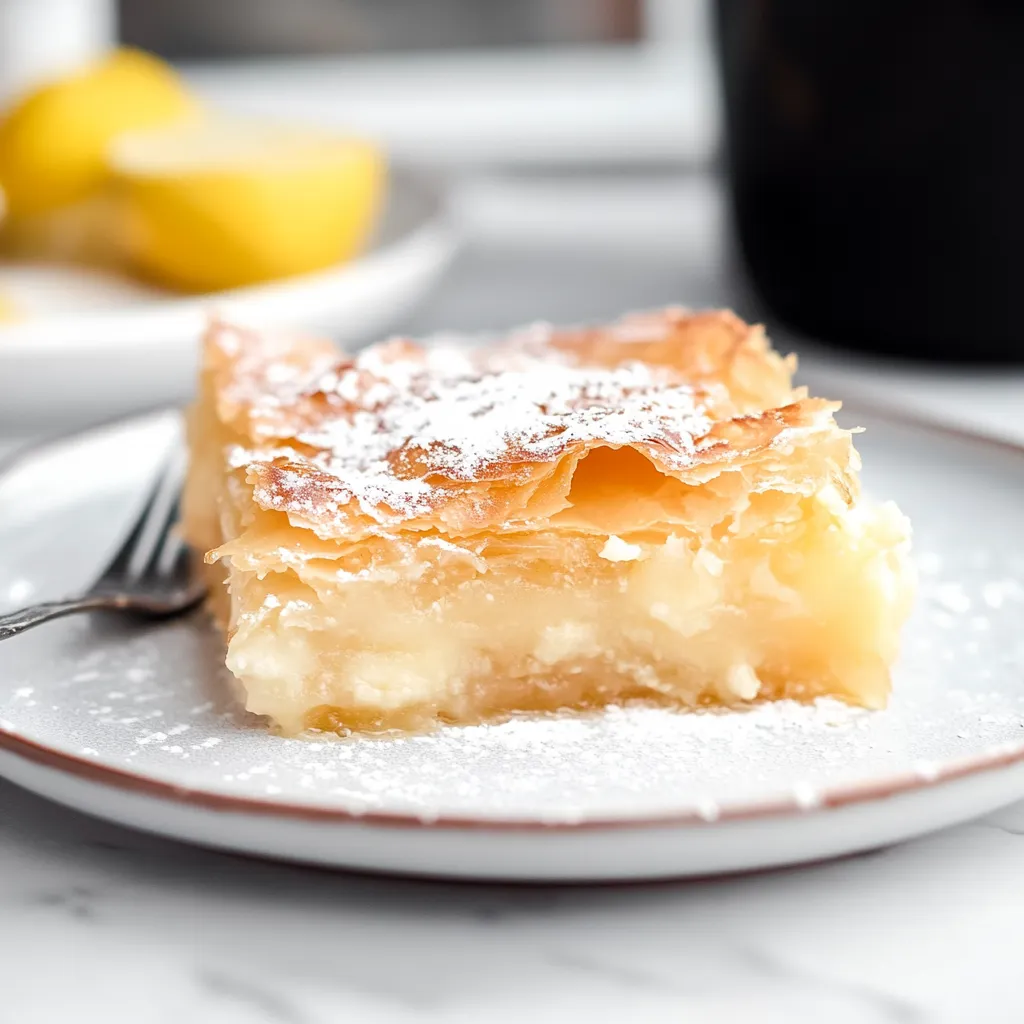 Pin it
Pin it
This creamy Greek custard pie wrapped in flaky filo dough is my absolute favorite weekend breakfast treat. Bougatsa combines the perfect balance of crispy layers with a velvety semolina custard center that will transport you straight to a seaside café in Thessaloniki.
I first tasted bougatsa during a family trip to Greece when I was a teenager. The warm, cinnamon-dusted pastry became our morning ritual, and recreating it at home always brings back memories of salty Mediterranean breezes and bustling market stalls.
Ingredients
- Large eggs: Provide structure and richness to the custard, make sure they're at room temperature for best results
- Butter: Adds a luxurious mouthfeel to both the custard and the filo layers, use unsalted for better control of flavor
- Sugar: Sweetens the custard just enough without overpowering, can adjust slightly to taste
- Milk: Creates the base for the custard, whole milk yields the creamiest results
- Fine semolina: Thickens the custard with a subtle texture, look for the finest grind available
- Vanilla extract: Adds aromatic depth to the filling, pure extract offers the best flavor
- Filo sheets: Create the signature crispy layers, allow them to thaw properly in the refrigerator overnight
- Melted butter: Helps achieve golden, crispy filo layers, brush generously between sheets
- Icing sugar: Dusted on top creates the classic finish, apply while still warm
- Cinnamon: Adds the traditional subtle warmth, Ceylon cinnamon has a more delicate flavor
Step-by-Step Instructions
 Pin it
Pin it
- Prepare the Eggs:
- Whisk the eggs thoroughly in a small bowl until completely combined and slightly frothy. The eggs need to be ready before making the custard since you will need to add them quickly while the milk mixture is hot. Set them aside within easy reach of your cooking area.
- Create the Custard Base:
- In a medium saucepan over medium heat, combine the quarter cup of butter and sugar. Whisk continuously until the butter completely melts and begins to incorporate with the sugar, about 2 minutes. The mixture should look smooth but not browned. Add the milk, fine semolina, and vanilla extract while continuing to whisk. Lower the heat to medium-low to prevent scorching. The gentle heat allows the semolina to absorb the liquid gradually without lumping.
- Temper and Thicken:
- Once the milk mixture is hot but not boiling, slowly stream in the whisked eggs while whisking vigorously with your other hand. This technique prevents the eggs from scrambling and ensures a silky custard. Continue whisking constantly for about 4 to 5 minutes until the mixture noticeably thickens to a pudding-like consistency that coats the back of a spoon. Remove from heat immediately and let cool slightly while preparing the filo.
- Prepare the Filo Base:
- Preheat your oven to 350°F and generously brush an 8x8 baking pan with melted butter, covering the bottom and sides completely. Lay the first sheet of filo in the pan, allowing the excess to hang over the edges. Brush this sheet completely with melted butter, making sure to reach the corners. Add another filo sheet, placing it slightly offset from the first for complete coverage. Brush with butter again. Repeat this process until you have a base of 5 buttered filo sheets.
- Add the Filling:
- Pour your slightly cooled custard into the prepared filo base, spreading it evenly with a spatula. Carefully fold the overhanging edges of the filo sheets over the custard, creating a partial envelope. Brush these folded edges with more melted butter to help them seal and crisp up during baking.
- Create the Top Layers:
- Take another sheet of filo and scrunch it slightly as you place it on top of the custard. The scrunching creates beautiful texture and height. Brush generously with butter, making sure to get into all the folds and crevices. Repeat with one final sheet of filo, scrunching it artistically and brushing thoroughly with butter. These top layers will become gloriously golden and crispy.
- Bake to Golden Perfection:
- Place the bougatsa in the preheated oven and bake for approximately 40 minutes, or until the top has turned a deep golden brown and the edges are crispy. You might want to rotate the pan halfway through for even browning. The custard inside should be set but still have a slight jiggle when the pan is gently shaken.
- Finish and Serve:
- Remove from the oven and allow to cool for 10 minutes. This brief cooling period helps the custard set further while still serving the bougatsa warm. Dust generously with icing sugar and cinnamon, creating the classic finishing touch. Slice into squares and serve while still warm for the most authentic experience.
My grandmother taught me to always let the custard cool slightly before adding it to the filo to prevent the sheets from becoming soggy. She would tell stories of making bougatsa for my grandfather every Sunday morning after they first married in Athens. Those precious kitchen memories make this recipe especially meaningful to me.
Make-Ahead Tips
Bougatsa is best enjoyed fresh from the oven while the filo is still crispy and the custard is warm. However, you can prepare the custard filling up to 24 hours in advance and store it in the refrigerator with plastic wrap pressed directly on the surface to prevent a skin from forming. When ready to use, gently warm it in a saucepan until just pourable before assembling with the filo sheets. This significantly cuts down on preparation time the day you plan to serve it.
Regional Variations
While this recipe features the sweet custard version of bougatsa that's most popular in Thessaloniki, other regions in Greece prepare savory variations. In some areas, the filling might consist of mizithra cheese similar to ricotta or even minced meat flavored with herbs and spices. The sweet version is traditionally dusted with powdered sugar and cinnamon, while the savory versions might be sprinkled with sesame seeds. Each region proudly claims their version as the most authentic!
Serving Suggestions
In Greece, bougatsa is typically enjoyed sliced into squares and served for breakfast alongside a strong Greek coffee. For an authentic experience, serve your bougatsa while still slightly warm with the powdered sugar and cinnamon freshly dusted on top. For a more substantial breakfast, pair with fresh fruit and Greek yogurt. As a dessert, consider adding a small scoop of vanilla ice cream or a drizzle of honey for extra indulgence.
 Pin it
Pin it
This bougatsa recipe will fill your home with the warm, sweet scents of Greece with every flaky, custard-filled bite.
Frequently Asked Questions
- → Can I make Bougatsa ahead of time?
Yes, you can prepare Bougatsa a day ahead. After baking, allow it to cool completely, then cover and refrigerate. Reheat in a 300°F oven for 10-15 minutes and dust with fresh powdered sugar and cinnamon before serving. However, Bougatsa is best enjoyed fresh when the filo is at its crispiest.
- → What is semolina and can I substitute it?
Semolina is a coarse flour made from durum wheat that gives the custard its unique texture. For authentic Bougatsa, semolina is essential. In a pinch, you could substitute with farina or cream of wheat, but the texture and flavor will differ from traditional Bougatsa.
- → Why is my filo dough tearing?
Filo dough dries out quickly when exposed to air. Keep unused sheets covered with a slightly damp kitchen towel while working. Also, ensure your filo is fully thawed if using frozen. Handle gently and work quickly to prevent tearing.
- → Can Bougatsa be frozen?
Yes, Bougatsa can be frozen after baking. Allow it to cool completely, then wrap individual portions in plastic wrap and aluminum foil. Freeze for up to one month. Thaw in the refrigerator overnight and reheat in a 300°F oven until warm. Add fresh powdered sugar and cinnamon before serving.
- → Is Bougatsa served hot or cold?
Bougatsa is traditionally served warm or at room temperature, never hot from the oven (as the custard needs time to set) or cold from the refrigerator. The ideal serving temperature allows you to enjoy both the crispy texture of the filo and the creamy consistency of the custard.
- → Can I make a savory version of Bougatsa?
Absolutely! While this is a sweet version, savory Bougatsa is also popular in Greece. For a savory variation, omit the sugar and vanilla, and fill with a mixture of feta cheese, eggs, and herbs like mint or parsley. The cooking method remains the same.
